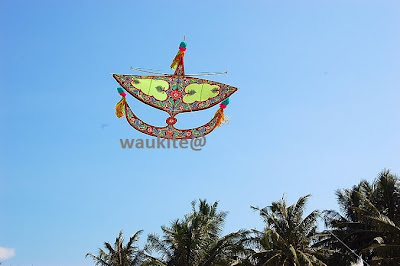 1. Trimming the bamboo for making the frames of a wau is an important aspect in Wau making. It will determine whether the frame is strong enough to take strong wind or flex enough to fly during light wind condition.
1. Trimming the bamboo for making the frames of a wau is an important aspect in Wau making. It will determine whether the frame is strong enough to take strong wind or flex enough to fly during light wind condition.
2. Before trimming the bamboo, one must establish on the conditions the Wau is to be flown. Even in a small country like Malaysia, the wind conditions is different depending on the time of the year and the location where the Wau is flown e.g. at the beach or inland.
3. There are a couple of techniques that a skilled Wau maker used to trim a bamboo. The simplest and easiest technique is as pictured above. The steps are as follows:
a. Cut the bamboo strip to the length required ensuring that there is a node in the centre and the culm length on either side is of the same length to ensure balance.
b. Split the bamboo near to the size required so that lesser trimming job is needed.
c. Sit on the floor or a stool; whichever is more convenient.
d. Place a piece of rag on the lap (left or right depending) so that it will not cause abrasion or spoil your pants.
e. Hold the bamboo strip at the centre node with one hand and the trimming knife on the other.
f. Decide the amount of bamboo to be trimmed by adjusting the angle of the cutting edge of the trimming knife and the amount of force to be exerted. Note that the steeper the angle of the cutting edge of the trimming knife and the greater the force applied will trim the greater amount of bamboo.
g. While holding the trimming knife static, draw the split bamboo against the cutting edge of the trimming knife.
h. Adjust the angle of the cutting edge and the amount of force as required. Roll the bamboo regularly so that a near cylindrical pencil like is achieved; tappering towards the end. Do not remove the bamboo skin as it will reduce the strength of the bamboo.
i. Regularly change trimming the left and right side of the centre node so that there is balance.
j. Repeat the process until you have achieved the desired size and flex.
4. Trimming a bamboo require skill but it is not too difficult to acquire. Practise will make perfect.
5. Split bamboo is sharp. Handle with care and take precaution. Happy trimming.















